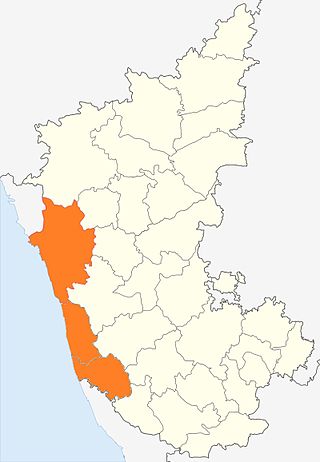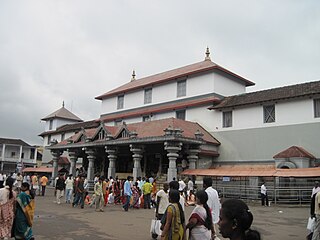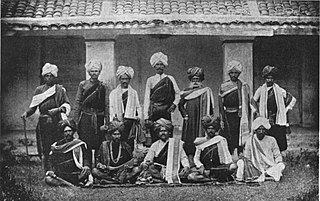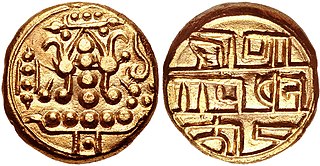Related Research Articles

Tulu is a Dravidian language whose speakers are concentrated in Dakshina Kannada and in the southern part of Udupi of Karnataka in south-western India and also in the northern parts of the Kasaragod district of Kerala. The native speakers of Tulu are referred to as Tuluva or Tulu people and the geographical area is unofficially called Tulu Nadu.

Kanara or Canara, also known as Karavali is the historically significant stretch of land situated by the southwestern coast of India, alongside the Arabian Sea in the present-day Indian state of Karnataka. The subregion comprises three civil districts, namely: Uttara Kannada, Udupi, and Dakshina Kannada. Kassergode was included prior to the States Reorganisation Act.

Dakshina Kannada district is located in the state of Karnataka in India, with its headquarters in the coastal city of Mangalore. It is part of the larger Tulu Nadu region. The district covers an area nestled in between the Western Ghats to its east and the Arabian Sea to its west. Dakshina Kannada receives abundant rainfall during the Indian monsoon. It is bordered by Udupi district to the north, Chikmagalur district to the northeast, Hassan district to the east, Kodagu to the southeast and Kasaragod district of Kerala to the south. According to the 2011 census of India, Dakshina Kannada district had a population of 2,083,625. It is the only district in Karnataka state to have all modes of transport like road, rail, water and air due to the presence of a major hub, Mangalore. This financial district is also known as the Cradle of Indian banking.

Tulu Nadu or Tulunad, also called Bermere Srishti or Parashurama Srishti, is a region and a proposed state on the southwestern coast of India. The Tulu people, known as 'Tuluva', speakers of Tulu, a Dravidian language, are the preponderant ethnic group of this region. South Canara, an erstwhile district and a historical area, encompassing the undivided territory of the contemporary Dakshina Kannada and Udupi districts of Karnataka State and Kasaragod district of Kerala state forms the cultural area of the Tuluver.
Havyaka Brahmins also and originally called Havika Brahmana are a Hindu Brahmin community native to districts of Shivamogga, Uttara Kannada, Dakshina kannada and coastal Karnataka, and the Kasaragod district of Kerala. Havyakas are known by their unique culture and language. They fall under the Pancha-Dravida Brahmin category are followers in general of mostly Yajurveda and some Rigveda and Samaveda Shakas. They follow the Advaita philosophy propounded by Adi Shankaracharya.

South Canara was a district of the Madras Presidency of British India, located at 13.00°N 75.40°E. It comprised the towns of Kassergode and Udipi and adjacent villages, with the administration at Mangalore city. South Canara was one of the most heterogeneous areas of Madras Presidency, with Tulu, Malayalam, Kannada, Konkani, Marathi, Urdu, and Beary languages being spoken side by side. It was succeeded by the Tulu-speaking areas of Dakshina Kannada district, the Malayalam-speaking area of Kasaragod district and the Amindivi islands sub-division of the Laccadives, in the year 1956.
The Tulu people or Tuluvas are an ethno-linguistic and ethno-cultural group from Southern India. They are native speakers of the Tulu language and the region they traditionally inhabit is known as Tulu Nadu. This region comprises the districts of Dakshina Kannada and Udupi in Karnataka and part of Kasaragod district in Kerala, with Mangalore, Karnataka being the commercial hub. The Census report of 2011 reported a population of 1,846,427 native Tulu speakers living in India.
The Bunt people are an Indian community who historically have inhabited the districts of coastal Karnataka, in South India. Bunts were traditionally a warrior-class community, with agrarian origins, forming the landed gentry of the region. They are the dominant land-owning and farming community of Tulu Nadu, and speak Tulu as well as Kundagannada as their mother tongue. Today, the Bunts are a largely urbanised community, with a population size of less than one million, worldwide.

D. Veerendra Heggade is an Indian philanthropist and the hereditary administrator of the Dharmasthala Temple. He succeeded to the post at the age of 19, on October 24, 1968, the 21st in his line. He administers the temple and its properties, which are held in trust for the benefit of devotees and of Dharma. He is a nominated Member of Parliament in the Rajya Sabha since July 2022.

Dharmasthala is an Indian temple town on the banks of the Nethravathi River in the Belthangady taluk of the Dakshina Kannada district in Karnataka, India.

Tigalari, also known as Tulu script, is a Southern Brahmic script which was used to write Tulu, Kannada, and Sanskrit languages. It was primarily used for writing Vedic texts in Sanskrit. It evolved from the Grantha script. It is called as Tigalari lipi in Kannada-speaking regions and Tulu speakers call it as Tulu lipi. It bears high similarity and relationship to its sister script Malayalam, which also evolved from the Grantha script.

Vokkaliga is a community, or a group of closely related castes, from the Indian state of Karnataka. They are also present in the neighbouring state of Tamil Nadu.
Ballal is a surname from coastal Karnataka in India. It is found among Hindu Samantha Arasu, Bunt and Jain Royal communities.

The Alupa dynasty was an ancient ruling dynasty of India. The kingdom they ruled was known as Alvakheda Arusasira and its territory spanned the coastal districts of the modern Indian state known as Karnataka. The Alupas in their prime were an independent dynasty, centuries after reigning due to the dominance of Kadambas from Banavasi, they became feudatory to them. Later they became the vassals of the Chalukyas, Rashtrakutas, Hoysalas with the change in political scenario of Southern India. Their influence over coastal Karnataka lasted for about 1200 years. There is evidence that the Alupas followed the law of matrilineal inheritance (Appekatt/Aliyasantana) since the Alupa king Soyideva was succeeded by his nephew Kulasekhara Bankideva. The legendary king who is credited with introducing matrilineality in Alva Kheda|Tulu Vishaya Kheda is named Bhuta Alupa Pandya The descendants of this dynasty still survive to this date and have spread in the karavali region and they are widely referred to as the Bunt. The Bunts follow Matrilineality instead of the common Patrilineality, and are said to be Nagavanshi Kshatriyas by their maternal origin. They can be identified with their surnames such as Shetty, Rai, Hegde, Alva, Chowta etc. Even though most Bunt are Hindus by faith now, The sizeable section of the community still follows Jainism and they are called Jain Bunt The last Alupa king to have ruled is Kulasekharadeva Alupendradeva whose inscription dated 1444 CE have been found in Mudabidri Jain Basadi.
Mangaloreans are a collection of diverse ethnic groups that hail from the historical locales of South Canara (Tulunaad) on the south western coast of Karnataka, India, particularly the residents native to Mangaluru.

Karkala, also known as Karla in Tulu language, is a town and the headquarters of Karkala taluk in the Udupi district of Karnataka, India. Located about 60 km from Mangalore in the Tulu Nadu region of the state, it lies near the foothills of the Western Ghats. Karkala has a number of natural and historical landmarks, and is a major tourist and transit destination due to its strategic location along the way to Hebri, Sringeri, Kalasa, Horanadu, Udupi, Kollur, Subrahmanya and Dharmasthala.

Tulu Nadu State movement is aimed at increasing Tulu Nadu's influence and political power through the formation of separate Tulu Nadu state from Karnataka and Kerala. Tulu Nadu is a region on the south-western coast of India. It consists of the Dakshina Kannada and Udupi districts of Karnataka and Kasargod district up to the Chandragiri river in Kerala. The Chandragiri River has traditionally been considered a boundary between Tulu Nadu and Kerala from the fourth century AD onwards. The first call for a separate Tulu Nadu state was made just after the Quit India Movement in 1942 by Srinivas Updhyaya Paniyadi, a banker and a press owner from Udupi. Mangalore is the largest and the chief city of Tulu Nadu. Tulu activists have been demanding a separate Tulu Nadu state since the late 2000s, considering language and culture as the basis for their demand.

Dharmasthala Temple is an 800-year-old Hindu religious institution in the temple town of Dharmasthala in Dakshina Kannada, Karnataka, India. The deities of the temple are Hindu god Shiva, who is referred to as Mañjunatha, Hindu goddess Ammanavaru, the Tirthankara Chandraprabha and the protective gods of Jainism, Kalarahu, Kalarkayi, Kumarasvami and Kanyakumari. The temple was reconsecrated in 16th century by Hindu Dvaita saint Vadiraja Tirtha by the request of the then administrator of the temple, Devaraja Heggade. The temple is considered unique, since the priests in the temple are Madhwa Brahmins, who are Vaishnava, and the administration is run by a Jain Bunt family called the Pergades.
Gowda is a surname native to Karnataka state of India. It is mainly found among the Vokkaligas in South Karnataka, Kurubas and the Lingayats in north Karnataka. It is also used by other communities like Namadhari Naiks, Billavas. Gowda was originally an honorific used by the administrative head of a village. Typically, such a head owned land and held political and social sway in the village. Among Kurubas, it was used to refer to the head of the community.
References
- ↑ Iyer, L. K. A. (1965). The Mysore Tribes and Castes, Volume 4. New Delhi: Mittal Publications. p. 27.
- 1 2 Whitworth, George Clifford (1885). An Anglo-Indian Dictionary: A Glossary of Indian Terms Used in English, and of Such English Or Other Non-Indian Terms as Have Obtained Special Meanings in India. London: K. Paul, Trench. p. 120.
- ↑ Nanjundayya, H V, L K Ananthkrishna Iyer (1931). The Mysore Tribes and Castes, Volume 4. Mysore: Mysore University. pp. 27, 28.
{{cite book}}: CS1 maint: multiple names: authors list (link) - ↑ H. V., Nanjundayya (1906). The Ethnographic Survey of Mysore, I. Kuruba Caste. Bangalore: The Government Press. pp. 1, 2.
- ↑ Singh, K. K. (1996). People of India, National Series Volume VIII, Communities, Segments, Synonyms, Surnames, and Titles. Oxford University Press, Anthropological Survey of India. p. 1499. ISBN 978-0-19-563357-3.
- ↑ "Hegde Name Meaning & Hegde Family History at Ancestry.com®". www.ancestry.com. Retrieved 2020-07-16.
- ↑ K. S. Singh (1998). India's Communities. Anthropological Survey of India Oxford University Press. p. 3677. ISBN 978-0-19-563354-2.
They are also known as Namdhari Gauda or Nadavaru. Heggade and Gowda are the titles , which they suffix to their names.
- ↑ "Hegde Family History". Oxford University Press. Dictionary of American Family Names ©2013, Oxford University Press.
- ↑ P, Gururaja Bhatt. Studies In Tuluva History And Culture. ASIN B00U28GNZG.
- ↑ Bhasker, Anand Saletore. Ancient Karnātaka, Volume I: History of Tuḷuva.
- ↑ N, Shyam Bhat. South Kanara (1799-1860): A Study in Colonial Administration and Regional Response,.
- ↑ B, Jagadeesh Shetty. The Agroeconomic Relations and Social Structure in Dakshina Kannada (A.D. 1000 to 1600).
- ↑ Naik, Shreedhara. Society and Politics in South Kanara A.D 1500-1800.